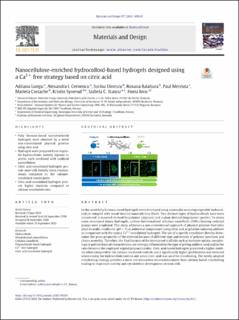| dc.contributor.author | Lungu, Adriana | |
| dc.contributor.author | Cernencu, Alexandra I. | |
| dc.contributor.author | Dinescu, Sorina | |
| dc.contributor.author | Balahura, Roxana | |
| dc.contributor.author | Mereuta, Paul | |
| dc.contributor.author | Costache, Marieta | |
| dc.contributor.author | Syverud, Kristin | |
| dc.contributor.author | Stancu, Izabela C. | |
| dc.contributor.author | Iovu, Horia | |
| dc.date.accessioned | 2023-01-13T13:34:39Z | |
| dc.date.available | 2023-01-13T13:34:39Z | |
| dc.date.created | 2021-11-25T12:35:21Z | |
| dc.date.issued | 2021 | |
| dc.identifier.citation | Materials & design. 2021, 197 . | en_US |
| dc.identifier.issn | 0264-1275 | |
| dc.identifier.uri | https://hdl.handle.net/11250/3043415 | |
| dc.description.abstract | In this work fully biomass-based hydrogels were developed using a naturally occurring vegetable hydrocolloid co-mingled with wood-derived nanocellulose fibrils. Two distinct types of hydrocolloids have been considered: a seaweed-derived biopolymer (alginate) and a plant-derived biopolymer (pectin). To attain nano-structured binary hydrogels, surface-functionalized cellulose nanofibrils (CNFs) bearing carboxyl groups were employed. This study addresses a non-conventional approach of physical gelation that takes place in acidic conditions (pH < 3) at ambiental temperature using citric acid as gelation-inducing additive in comparison with the typical Ca2+-crosslinked hydrogels. The use of a specific crosslinker directly determines the gross properties of the material because of different type and density of polymer junctions and chains assembly. Therefore, the final features of the bioinspired scaffolds such as moisture uptake, morphological and mechanical characteristics are strongly influenced by the type of gelling additive used and by the ratio between the employed vegetal polysaccharides. Citric acid-based hydrogels presented a higher stability when compared to the calcium-mediated controls and a significantly higher proliferation was detected when raising the hydrocolloid content and when citric acid was used for crosslinking. The newly adopted crosslinking strategy provides a more cell-interactive microenvironment than calcium-based crosslinking leading to improved viability and cytoskeleton development of stem cells. | en_US |
| dc.language.iso | eng | en_US |
| dc.publisher | Elsevier | en_US |
| dc.rights | Navngivelse 4.0 Internasjonal | * |
| dc.rights.uri | http://creativecommons.org/licenses/by/4.0/deed.no | * |
| dc.title | Nanocellulose-enriched hydrocolloid-based hydrogels designed using a Ca2+ free strategy based on citric acid | en_US |
| dc.title.alternative | Nanocellulose-enriched hydrocolloid-based hydrogels designed using a Ca2+ free strategy based on citric acid | en_US |
| dc.type | Peer reviewed | en_US |
| dc.type | Journal article | en_US |
| dc.description.version | publishedVersion | en_US |
| dc.source.pagenumber | 0 | en_US |
| dc.source.volume | 197 | en_US |
| dc.source.journal | Materials & design | en_US |
| dc.identifier.doi | 10.1016/j.matdes.2020.109200 | |
| dc.identifier.cristin | 1958975 | |
| cristin.ispublished | true | |
| cristin.fulltext | original | |
| cristin.qualitycode | 1 | |

